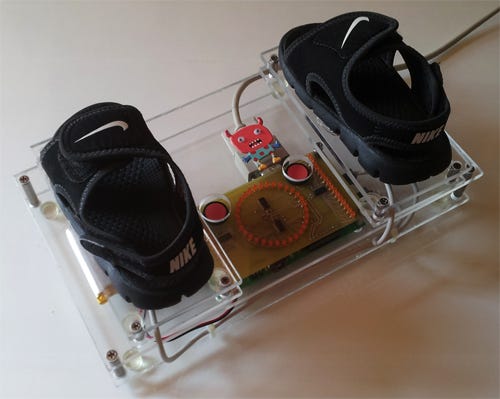How a Dad Designed a Power Wheelchair for His Son
December 4, 2013
A Chicago man has successfully modified a power wheelchair so that his mostly incapacitated toddler can actually use it--with his feet.
Shea Kanani Ako's 2-year-old boy Alejandro suffers from spinal muscular atrophy, a genetic defect in that kills neurons in a person's spinal cord anterior horn and causes muscular atrophy across the body and an inability to move or breathe on one's own, according to reports in Hack a Day and Hawaii News Now. (Shea is an O'ahu native.)
Blue Cross Blue Shield of Illinois told Shea Kanani Ako that it wouldn't pay for a power wheelchair for five years, a situation Kanani considered unacceptable because he wanted Alejandro to be able to explore like a healthy child.
|
After unsuccessfully trying to repair a digital kitchen scale, Shea Kanani Ako hit upon the idea of cribbing the sensors from the device in order to create a foot-based controller. |
Shea Kanani Ako found a motorized wheelchair selling for $800 eBay, but it had a joystick-style control that Alejandro was unable to use.
But after unsuccessfully trying to repair a digital kitchen scale, Shea Kanani Ako hit upon the idea of cribbing the sensors from the device in order to create a foot-based controller.
The result is that Alejandro is now able to move himself forward and backward, as well as steer around, using only the tiniest bit of pressure employed by his toes.
A digital to analog converter chip stands in for the original analog joystick, connecting the pedal system to the wheelchair.
Shea Kanani Ako has posted a detailed, technical blow-by-blow account of how he modified the chair. The description is licensed under a Creative Commons attribution, and should hopefully inspire other parents facing similar hurdles.
Hawaii News Now says:
"Kanani has no plans to patent any of his inventions--in fact, he's doing the exact opposite by sharing everything he's learned and developed with others. His father, Julian Ako [local high school principal], calls him inspiring. ... Family members say it is likely Alejandro's condition will degenerate further and he will probably lose all ability to move his fingers and toes, but Kanani is preparing himself. He's already working on a new project, a brain computer interface that will enable Alejandro to pilot a wheelchair and communicate using brain activity."
Chris Newmarker is senior editor of MPMN and Qmed. Follow him on Twitter at @newmarker.
About the Author(s)
You May Also Like


.png?width=300&auto=webp&quality=80&disable=upscale)
